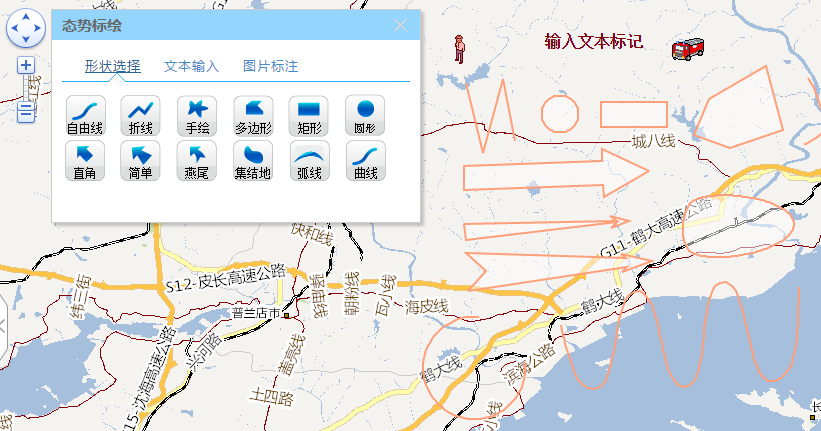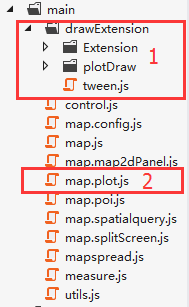preface
Refer to ArcGIS api 3.0 on esri's official website for the api used in the function implementation of this article and the classes involved that cannot be understood x for js: esri official website api , which introduces ArcGIS API in detail X introduction to various classes and online examples: esri official website online example , this is also learning ArcGIS API 3 Good material for X.
Content overview
- Basic drawing of Draw tool based on arcgis aqpi
- Expand drawing tools
- Source code demo download
This chapter implements the map situation plotting function module, and the screenshot is as follows:


The core of this article is to call the Draw tool of arcgis aqpi: Draw
require(["esri/toolbars/draw"], function(Draw) { /* code goes here */ });
Constructor:
new Draw(map, options?)
Generally speaking, it is OK to pass the parameter map object in. Other parameters are optional, and the default is OK, unless you want to set them specifically.
The default paintable graphics type constant Constants:
ARROW Draws an arrow.arrow CIRCLE Draws a circle.circular DOWN_ARROW Draws an arrow that points down.Down arrow ELLIPSE Draws an ellipse.ellipse EXTENT Draws an extent box.rectangle FREEHAND_POLYGON Draws a freehand polygon.Hand drawn polygon FREEHAND_POLYLINE Draws a freehand polyline.Hand drawn line LEFT_ARROW Draws an arrow that points left.left arrow LINE Draws a line.Line MULTI_POINT Draws a Multipoint.Multipoint POINT Draws a point.spot POLYGON Draws a polygon.polygon POLYLINE Draws a polyline.broken line RECTANGLE Draws a rectangle.rectangle RIGHT_ARROW Draws an arrow that points right.Right key head TRIANGLE Draws a triangle.triangle UP_ARROW Draws an arrow that points up.up arrow
You can set the symbol style for drawing:


The activate function can activate the behavior that triggers drawing. After drawing, get the geometry in the drawing end event:
activate(geometryType, options?)

The idea of map plotting is to realize common point line and surface rendering by using Draw tool of arcgis api. However, special military situations such as swallow tail arrow, assembly ground, arcs, curves and simple arrows need to be customized to draw. Therefore, it is necessary to expand Draw tools to achieve it, and this is also the essence of this article.
- Let's talk about how to expand the Draw class js file in the project reference:

1. Inherit and expand the file directory of Draw; 2 is the js file to realize the situation plotting module.
First, you need to create a map HTML page reference:
<script type="text/javascript">
//Configure arcgis to expand and resolve the path referenced by the sky map service class
dojoConfig = {
parseOnLoad: true,
packages: [{
name: 'tdlib',
location: this.location.pathname.replace(/\/[^/]+$/, "") + "/js/tdlib"
}],
paths: {
Extension: location.pathname.replace(/\/[^/]+$/, "") + "/js/main/drawExtension/Extension",
ExtensionDraw: location.pathname.replace(/\/[^/]+$/, "") + "/js/main/drawExtension/plotDraw"
}
};
</script>
Where paths represents the path to be referenced.
<script type="text/javascript" src="js/main/map.plot.js"></script>
Secondly, in map js file initialization refers to the expanded js files DrawEx and DrawExt:
(function () {
dojo.require("Extension.DrawEx");
dojo.require("ExtensionDraw.DrawExt");
})();
Finally, call plot in the situation plotting menu response event of the toolbar menu JS:
//Situation plotting
$("#bPlot").click(function () {
//Initialize military potential plotting interface
if (!DCI.Plot.isload)
DCI.Plot.Init(map);
if (DCI.Plot.dialog)
DCI.Plot.dialog.close();
DCI.Plot.dialog = jDialog.dialog({
title: 'Situation plotting',
width: 370,
height: 200,
left: 450,
top: 200,
modal: false, // Non modal, that is, the mask layer is not displayed
content: DCI.Plot.Html
});
DCI.Plot.InitEvent();
});
- Talk about the idea of drawing tool call. Whether you call arcgis api's original drawing or expand drawing, you first create a Draw object, then listen to the Draw end callback function of Draw, obtain the drawn graphics and overlay them on the map display; The activate function of the Draw tool will trigger the Draw end callback function;
First, initialize the Draw tool object and the default symbol style symbol:
//Define default point, line, and face symbols
DCI.Plot.markerSymbol = new esri.symbol.SimpleMarkerSymbol(esri.symbol.SimpleMarkerSymbol.STYLE_CIRCLE, 8, new esri.symbol.SimpleLineSymbol(esri.symbol.SimpleLineSymbol.STYLE_SOLID, new dojo.Color([255, 69, 0]), 2), new dojo.Color([255, 255, 255, 1]));
DCI.Plot.lineSymbol = new esri.symbol.SimpleLineSymbol(esri.symbol.SimpleLineSymbol.STYLE_SOLID, new dojo.Color([255, 160, 122]), 2);
DCI.Plot.fillSymbol = new esri.symbol.SimpleFillSymbol(esri.symbol.SimpleFillSymbol.STYLE_SOLID, new esri.symbol.SimpleLineSymbol(esri.symbol.SimpleLineSymbol.STYLE_SOLID, new dojo.Color([255, 160, 122]), 2), new dojo.Color([255, 255, 255, 0.5]));
//Initialize Draw
DCI.Plot.toolbar = new Extension.DrawEx(map);
DCI.Plot.toolbar.on("draw-end", DCI.Plot.addToMap);
DCI.Plot.toolbar1 = new ExtensionDraw.DrawExt(map);
DCI.Plot.toolbar1.on("draw-end", DCI.Plot.addToMap);
//Draw of arcgis api
DCI.Plot.drawToolbar = new esri.toolbars.Draw(map);
DCI.Plot.drawToolbar.markerSymbol = DCI.Plot.markerSymbol;
DCI.Plot.drawToolbar.lineSymbol = DCI.Plot.lineSymbol;
DCI.Plot.drawToolbar.fillSymbol = DCI.Plot.fillSymbol;
DCI.Plot.drawToolbar.on("draw-end", DCI.Plot.drawEnd);
Secondly, trigger the call to Draw:
case 0://plot_freehandline
DCI.Plot.drawFreeHandPolyline(null, function (geometry) {
symbol = DCI.Plot.lineSymbol;
DCI.Plot.drawEndPlot(geometry, symbol);
});
break;
case 1://plot_line
DCI.Plot.drawPolyline(null, function (geometry) {
symbol = DCI.Plot.lineSymbol;
DCI.Plot.drawEndPlot(geometry, symbol);
});
break;
case 2://emergency_freehand
DCI.Plot.drawFreeHandPolygon(null, function (geometry) {
symbol = DCI.Plot.fillSymbol;
DCI.Plot.drawEndPlot(geometry, symbol);
});
break;
case 3://plot_polygon
DCI.Plot.drawPolygon(null, function (geometry) {
symbol = DCI.Plot.fillSymbol;
DCI.Plot.drawEndPlot(geometry, symbol);
});
break;
case 4://plot_extent
DCI.Plot.drawExtent(null, function (geometry) {
symbol = DCI.Plot.fillSymbol;
DCI.Plot.drawEndPlot(geometry, symbol);
});
break;
case 5://emergency_freehand
DCI.Plot.drawCircle(null, function (geometry) {
symbol = DCI.Plot.fillSymbol;
DCI.Plot.drawEndPlot(geometry, symbol);
});
break;
case 6://Right angle arrow
DCI.Plot.drawStraightArrow(null, function (geometry) {
symbol = DCI.Plot.fillSymbol;
DCI.Plot.drawEndPlot(geometry, symbol);
});
break;
case 7://Simple arrow
DCI.Plot.toolbar.activate(Extension.DrawEx.FREEHAND_ARROW);
break;
case 8://Dovetail arrow
DCI.Plot.toolbar1.fillSymbol = DCI.Plot.fillSymbol;
DCI.Plot.toolbar1.activate("tailedsquadcombat");
break;
case 9://Assembly site
DCI.Plot.toolbar.activate(Extension.DrawEx.BEZIER_POLYGON);
break;
case 10://Arc
DCI.Plot.toolbar.activate(Extension.DrawEx.CURVE);
break;
case 11://curve
DCI.Plot.toolbar.activate(Extension.DrawEx.BEZIER_CURVE);
break;
//Draw point
drawPoint: function (symbol, onDrawEnd) {
DCI.Plot.onDrawEnd = onDrawEnd;
if (symbol) {
DCI.Plot.drawToolbar.markerSymbol = symbol;
}
DCI.Plot.drawToolbar.activate(esri.toolbars.Draw.POINT);
DCI.Plot.disablePan();
},
//Draw a polyline
drawPolyline: function (symbol, onDrawEnd) {
this.onDrawEnd = onDrawEnd;
if (symbol) {
this.drawToolbar.lineSymbol = symbol;
}
this.drawToolbar.activate(esri.toolbars.Draw.POLYLINE);
this.disablePan();
},
//Free line
drawFreeHandPolyline: function (symbol, onDrawEnd) {
this.onDrawEnd = onDrawEnd;
if (symbol) {
this.drawToolbar.lineSymbol = symbol;
}
this.drawToolbar.activate(esri.toolbars.Draw.FREEHAND_POLYLINE);
this.disablePan();
},
//Draw polygon
drawPolygon: function (symbol, onDrawEnd) {
this.onDrawEnd = onDrawEnd;
if (symbol) {
this.drawToolbar.fillSymbol = symbol;
}
this.drawToolbar.activate(esri.toolbars.Draw.POLYGON);
this.disablePan();
},
//Hand drawn polygon
drawFreeHandPolygon: function (symbol, onDrawEnd) {
this.onDrawEnd = onDrawEnd;
if (symbol) {
this.drawToolbar.fillSymbol = symbol;
}
this.drawToolbar.activate(esri.toolbars.Draw.FREEHAND_POLYGON);
this.disablePan();
},
//Draw a circle
drawCircle: function (symbol, onDrawEnd) {
this.onDrawEnd = onDrawEnd;
if (symbol) {
this.drawToolbar.fillSymbol = symbol;
}
this.drawToolbar.activate(esri.toolbars.Draw.CIRCLE);
this.disablePan();
},
//Draw rectangle
drawExtent: function (symbol, onDrawEnd) {
this.onDrawEnd = onDrawEnd;
if (symbol) {
this.drawToolbar.fillSymbol = symbol;
}
this.drawToolbar.activate(esri.toolbars.Draw.EXTENT);
this.disablePan();
},
//Right angle arrow
drawStraightArrow: function (symbol, onDrawEnd) {
this.onDrawEnd = onDrawEnd;
if (symbol) {
this.drawToolbar.fillSymbol = symbol;
}
this.drawToolbar.activate(esri.toolbars.Draw.ARROW);
this.disablePan();
},
Finally, add drawing graphics to display on the map:
/**
* Function called after drawing
*/
drawEndPlot: function (geometry,symbol) {
var title = "title";
var htmlCon = "Test content test content";
var attr = { "title": title, "content": htmlCon};
var graphic = new esri.Graphic(geometry, symbol, attr);
DCI.Plot.graphicslayer.add(graphic);
DCI.Plot.deactivateDraw();
DCI.Plot.map.setMapCursor('auto');//Set the mouse cursor
}
/**
* Expand the function called after drawing
*/
addToMap: function (evt) {
DCI.Plot.map.setMapCursor('auto');//Set the mouse cursor
var symbol;
DCI.Plot.toolbar.deactivate();
DCI.Plot.toolbar1.deactivate();
switch (evt.geometry.type)
{
case "point":
case "multipoint":
symbol = DCI.Plot.markerSymbol;
break;
case "polyline":
symbol = DCI.Plot.lineSymbol;
break;
default:
symbol = DCI.Plot.fillSymbol;
break;
}
var title = "title";
var htmlCon = "Test content test content";
var attr = { "title": title, "content": htmlCon};
var graphic = new esri.Graphic(evt.geometry, symbol, attr);
DCI.Plot.graphicslayer.add(graphic);
}